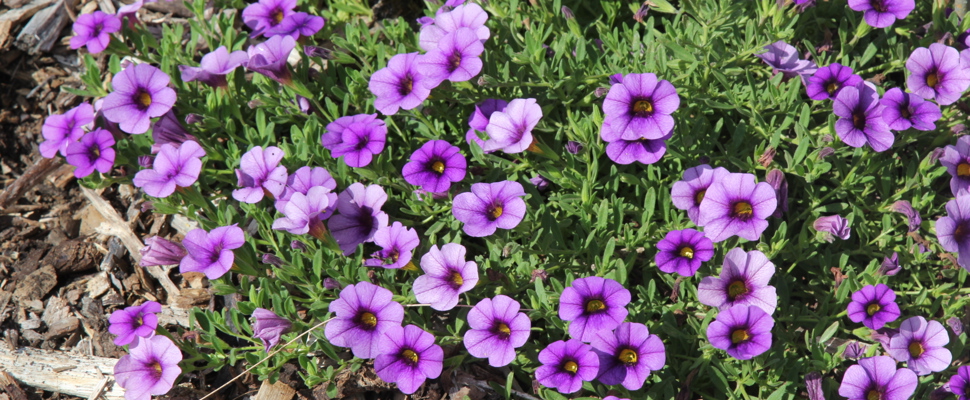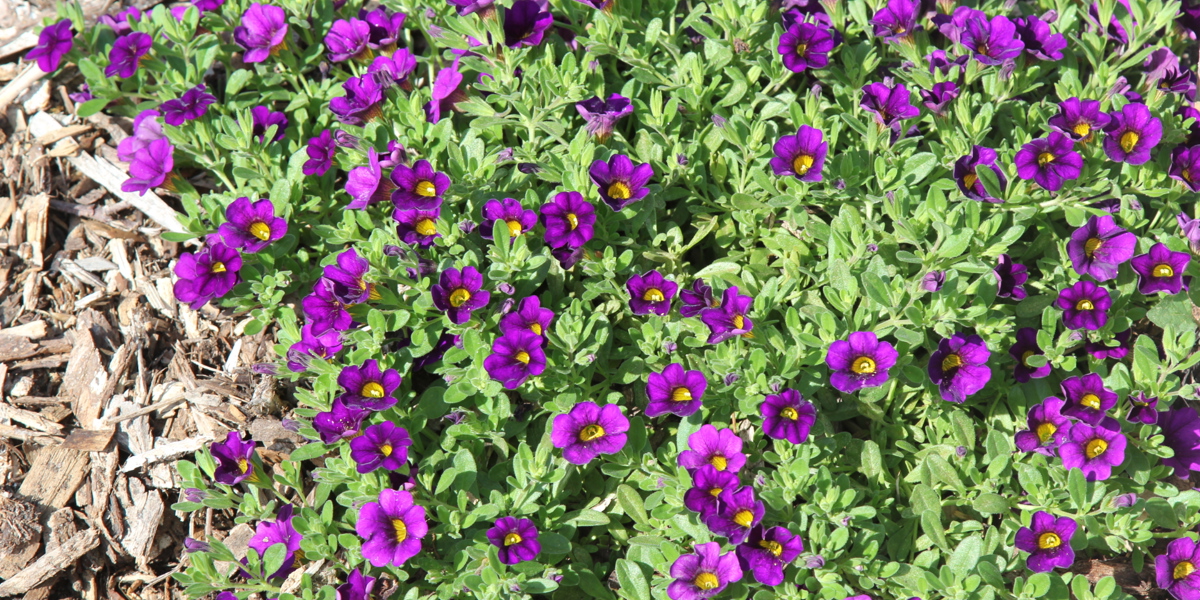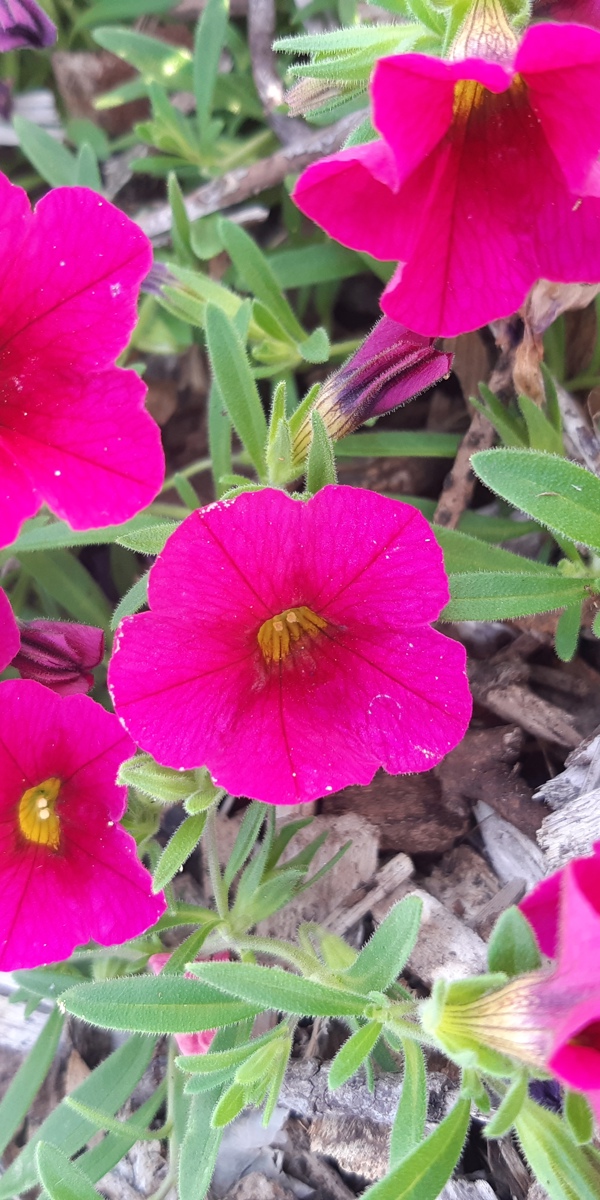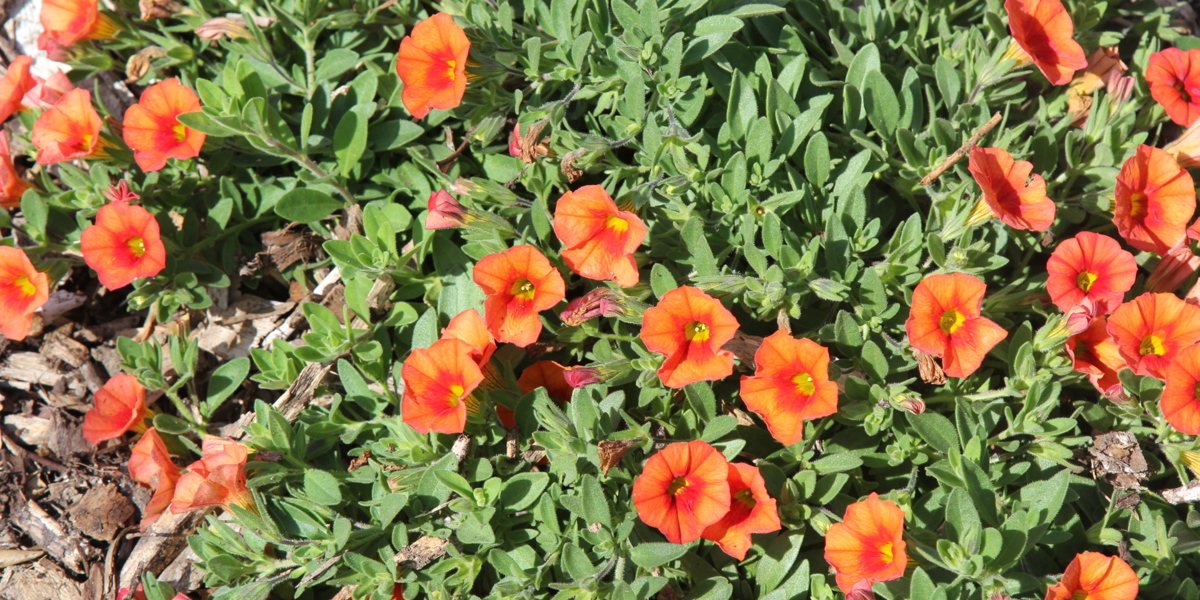
Calibrachoa bedding trial
Summer annuals 2019/2020
Introduction
At Auckland Botanic Gardens (ABG) we make two main plantings in our annual beds each year, one in autumn for winter/spring display, the other in early summer for summer/autumn colour. By comparison, some other public gardens plant annual beds three times a year. We therefore require high performing annuals with long flowering periods. We also look for minimal maintenance and healthy plants that don’t require pesticides. Ideally, they should self-groom (shed their spent flower heads) and have dense habits that suppress weed growth. Plants undergo assessment in our trial garden to indicate their performance in highly visible mass planted beds.
There are 28 species of Calibrachoa (Solanaceae family) and many cultivars have been developed in a range of flower colours. Calibrachoa have a native range from the south-west United States of America, Mexico, Brazil to southern South America. Also known as million bells, they are sometimes still referred to as petunias; Petunia and Calibrachoa are closely related but are now considered separate genera.
With their cascading habit and masses of colourful flowers, Calibrachoa are popular garden plants used in pots and hanging baskets. They perform well in full sun, in fertile, free-draining soil.
The aim of this trial was to identify high performing Calibrachoa for summer bedding that profusely flower for 5–6 months, have flowers that do not fade or need deadheading, provide effective ground cover, have a high survival rate, are low maintenance, and pest and disease-free. It is also important that flowers are not adversely affected by the summer rains so common in Auckland.
Methods
Six cultivars of Calibrachoa from the KabloomTM series were grown from seed and planted in the trial bed on November 15th, 2019. The Kabloom™ Calibrachoa series was bred by Jason Jandrew, of PanAmerican Seed, for seed production and range of colour. Ten plants of each cultivar were planted at 50 cm spacing. Plants were deadheaded at the time of planting. No soil amendments were added before planting. Plants were all, on average, 9 cm wide and 3 cm tall at the time of planting. Plants were hand-watered at the base of the plants 2–3 times a week through the duration of the trial.
Weekly data was collected on flowering (using the scale 0 = nothing, 1 = buds, 2 = flowers, 3 = old flowers), and the percentage of each plant covered in flowers was estimated in the field then an average was calculated for each cultivar. Peak flowering was identified when 80% or more of the plant was flowering.
Once a month, observations of any pests or diseases were recorded with a percentage estimated of each plant affected. At maturity, the width and height were measured for all plants and then was averaged. Once during the trial period, the flower colour for each cultivar was analysed using the Royal Horticultural Society (RHS) colour charts. At the end of January, an evaluation by a group of staff was conducted to assess plants overall and rate them according to ABG star performer criteria (1 = poor performer to 10 = excellent performer). Cultivars that scored 8 or more are considered top performers and are recommended for Auckland conditions. The overall rating took into consideration flowering period, absence of pests and diseases, habit and vigour.
The trial concluded about a month earlier than scheduled due to the closure of the gardens in response to SARS coronavirus 2 (COVID-19). The last date of data collection was March 19th, 2020.
Results
Calibrachoa ‘Kabloom Orange’ and C. ‘Kabloom Pink’ are the largest cultivars in both height and width and therefore provide effective ground cover quickly (Table 1).
All cultivars flowered from mid-November to late March, although there were differences in peak flowering. C. ‘Kabloom Denim’ had the shortest flowering period and fewer blooms compared to the other cultivars, and its flower colour faded, but this was expected from this cultivar based on its name. C. ‘Kabloom Light Pink Blast’ flowers faded over time and there were few flowers in the centre of the plant. Striking flower colours were displayed by C. ‘Kabloom Blue’, C. ‘Kabloom Cherry’, C. ‘Kabloom Orange’ and C. ‘Kabloom Pink’ and with no colour fade observed (Table 2).
In terms of pests and diseases, C. ‘Kabloom Orange’ and C. ‘Kabloom Pink’ were less affected than the other cultivars. A general pattern across all cultivars was seen with low rust symptoms during November and December (less than 30% of plants affected), mites seen on plants during January and February (less than 40% of plants affected by mites) and aphids present throughout the summer. Because aphids were seen throughout summer, and the other pests were not, we were able to calculate their averages and present them in Table 1.
Due to much lower than usual summer rainfall it was not possible to ascertain the tolerance of flowers to rain.
Table 1 Summary table of 6 Calibrachoa trialled for peak flowering period, habit/size, pests and diseases (percentage of plants affected) and given an overall rating. Selections with an overall rating of 8 or higher are recommended as top performers and indicated by asterisks.
|
Calibrachoa cultivar |
Peak flowering period |
Size (height × width cm) |
Pest and disease (%) |
Overall rating |
|
C. ‘Kabloom Blue’ (Fig. 1) |
February to early March |
7 × 29 |
Aphids (37.5%) |
6 |
|
C. ‘Kabloom Cherry’ (Fig. 2) |
February to late March |
7 × 28 |
Aphids (35%) |
7 |
|
C. ‘Kabloom Denim’ (Fig. 3) |
Mid-February |
7 × 28 |
Aphids (43%) |
6 |
|
C. ‘Kabloom Light Pink Blast’ (Fig. 4) |
Mid-January to early March |
9 × 40 |
Aphids (32.5%) |
6 |
|
C. ‘Kabloom Orange’ (Fig. 5) |
Late January to late March |
13 × 41 |
Aphids (27.5%) |
8* |
|
C. ‘Kabloom Pink’ (Fig. 6) |
Mid-January to late March |
12 × 38 |
Aphids (27.5%) |
8* |
NB: end of flowering period is not accurate based on the trial concluding early and typically would have continued observations for another 2–3 weeks.
Table 2 Flower description and colour using RHS colour charts.
|
Calibrachoa cultivar |
Description |
RHS colour chart |
|
C. ‘Kabloom Blue’ |
Mini-petunia like flowers, purpley-blue with a purple tone ring and yellow throat. |
Violet group N88A |
|
C. ‘Kabloom Cherry’ |
Mini-petunia like flowers, red with a darker tone ring and yellow throat. |
Red-purple group 67A |
|
C. ‘Kabloom Denim’ |
Mini-petunia like flowers, light-purpley-blue with a darker tone ring and yellow throat. |
Violet group 85C and N87A |
|
C. ‘Kabloom Light Pink Blast’ |
Mini-petunia like flowers, light-pink tones with a red ring and yellow throat. |
Red-purple group 62C and 68B |
|
C. ‘Kabloom Orange’ |
Mini-petunia like flowers, bright orange with a darker orange ring and yellow throat. |
Greyed-orange group 169B |
|
C. ‘Kabloom Pink’ |
Mini-petunia like flowers, bright pink with a darker tone ring and yellow throat. |
Red-purple group N74A |
Conclusions
From this trial, we recommend C. ‘Kabloom Orange’ and C. ‘Kabloom Pink’ which were rated 8 overall with consistent long prolific flowering, good sized habit, minimal pest and diseases, and no maintenance.
In general, all plants had small dense green foliage with trailing/spreading and open sprawling habits.
Within most cultivars, there was some variability in the height and width of individual plants. We therefore recommend using these calibrachoas in pockets, rather than in large drifts or as a single bedding crop.
Websites
Kew Science: Plants of the World Online: Calibrachoa
This article cannot be republished elsewhere without written consent from Auckland Botanic Gardens. Originally published in the New Zealand Garden Journal 23(1).





